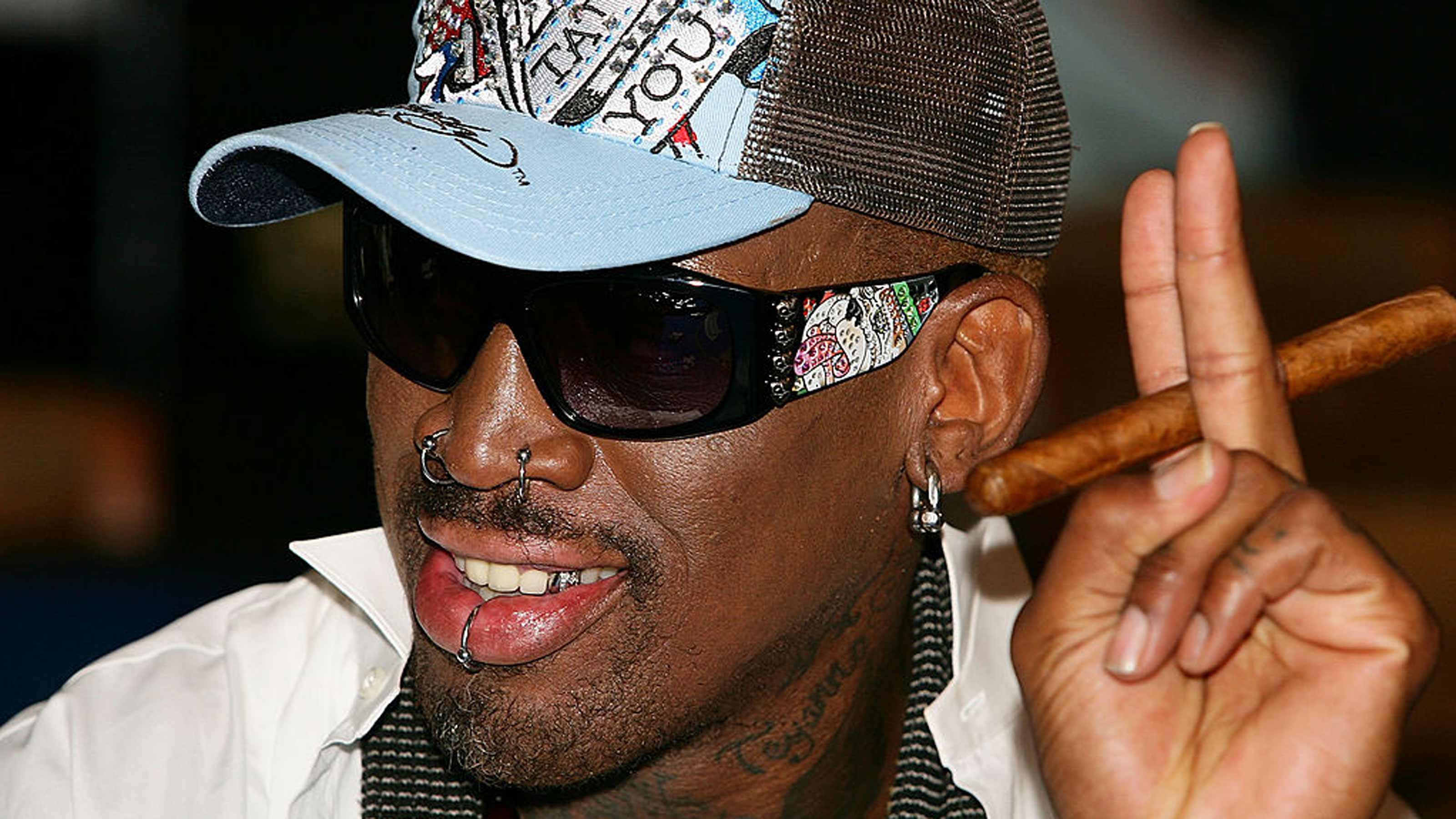It May Be Time to Swap the 60/40 Portfolio for a 40/60 Portfolio Instead
If the traditional “60/40 portfolio” is dead, what should investors do? For a clue, turn to the Chicago Bulls and see what we can learn from the Worm (aka Dennis Rodman), Toni Kukoc and Steve Kerr.


What does Dennis Rodman, one of the most colorful basketball players in NBA history, have to do with your investment portfolio? I first heard this idea from an interview with Christopher Cole from Artemis Capital Management did last year, and I thought it would be a fun exercise to expound on Chris’ paper from 2016 on Rodman’s impact.
As one of lowest scoring inductees in the Basketball Hall of Fame, Rodman was never a threat to score, yet when he was on the floor, the offensive efficiency of his teams went through the roof.
Put Rodman on a mediocre offensive team, and they became a good offensive team. Put him on the floor with two of the best players to ever play the game and something special happens.

Sign up for Kiplinger’s Free E-Newsletters
Profit and prosper with the best of expert advice on investing, taxes, retirement, personal finance and more - straight to your e-mail.
Profit and prosper with the best of expert advice - straight to your e-mail.
I experienced this firsthand as a young fan in 1996 when Rodman and the Bulls met my Seattle Supersonics in the NBA finals. Without Rodman, the Bulls had already won three NBA titles by relying on Michael Jordan and Scottie Pippen’s unique talents. With Rodman, they became arguably the best team of all time.
I know, you are still wondering, what does this have to do with my investment portfolio?
Rodman’s Defense Balanced the Bulls’ Basketball Portfolio
For the past 40 years, we have been in a long-term bull market in both stocks and bonds. During this time, the simple idea of a portfolio balanced with 60% equities and 40% bonds (The 60/40 portfolio) has performed extremely well. Interest rates have fallen from the mid-teens to near zero, providing bonds with a large price appreciation to more than make up for lower and lower coupon rates. At the same time, bonds provided a great hedge against stock market volatility as times of market distress were usually times where interest rates were lowered, which supported higher bond prices.
That stock/bond relationship is much like that of the dynamic duo of basketball stars on the Bulls: If Jordan happened to have an off game, Pippen was there to pick up the slack. But if this strategy has worked – whether it’s Jordan and Pippen or 60/40 – why mess with a good thing?
Let’s get back to Dennis Rodman. In his days as a Detroit Piston, Rodman earned a reputation as one of the greatest rebounders of all time, particularly offensive rebounding. In his best season, Rodman averaged more than 18 rebounds per game. If six of those were offensive rebounds, you are giving Michael Jordan and Scottie Pippen enough second and third shots throughout the game. If Jordan and Pippen converted half of those opportunities, that equated to an additional six points per game.
That is enough second chances to take a great team and make them almost unbeatable.
In isolation, it is hard to consider Rodman among the best players in NBA history. A team of Rodmans (or Rodmen, I am unsure how to pluralize his name) would not be very good, but paired with the right teammates, he is unstoppable.
This is how we believe portfolios will need to be managed going forward.
In our research last year while we were reviewing our models and how we approached the market during the pandemic, we came across a research report that has made a profound impact on our thinking. The report, “The Allegory of the Hawk and Serpent” by Chris Cole, posed the question: How would you invest your money if you could not change your allocation for 100 years? This question is so important because what has worked for the last 40 years – the 60/40 Portfolio – did not work nearly as well if you go back and look at the 50 years prior to 1980.
The asset class identified in this research, that — when added to a stock and bond portfolio, along with a couple of other role players — can provide a similar outcome as Dennis Rodman did with the Bulls is this: long volatility.
What is Long Volatility
In the same interview where I first heard the Rodman analogy, Chris Cole described long volatility in both market terms and life terms with Jason Buck, founder of Mutiny Fund.
In markets, long volatility means making change work to your benefit. There may be some upfront cost to gain exposure to long volatility, but it can transform extreme change that brings liquidity back into your portfolio when you need it most. This often comes in the form of an option, which you pay upfront for and can profit from extreme movements to the right tail (inflation) or left tail (deflation) of the risk spectrum. The potential profit during these extreme movements is non-linear and typically occurs in times of secular change. For example, when the market is experiencing extreme stress like March of 2020, you would expect long volatility strategies to have significant positive performance.
In life terms, the same rules apply. The cost in this case may be time – time to meditate or work out or time and money investing in your personal or professional growth – that can lead to a positive change in your life. This type of trade-off is how long volatility works in your investment portfolio.
As an asset class, investments that capitalize on long volatility tend to be anti-correlated with the market and tend to do best when there is a lack of liquidity: when stocks are crashing, when bonds are malfunctioning, when there are terrible credit drawdowns. When the rest of the world is drawing liquidity out of the system, long volatility is bringing liquidity back into your portfolio.
To bring us back to Dennis Rodman, in the fourth quarter of a game, when you are trailing by a few points, long volatility is grabbing the offensive rebounds and giving your other assets classes those second and third shots when they are down.
Identifying the Kerrs and Kukocs in Your Portfolio?
In addition to Dennis Rodman, you need other role players. From an investment perspective, think of gold as your Steve Kerr, or commodity trend following (which is identifying the long-term trend in the price movement of commodities and letting your winners run and cutting your losers as quickly as possible, specifically in commodities) as your Toni Kukoc. Looking back over 90 years, these other asset classes play critical supporting roles to creating a winning team.
In investing, people underestimate defense, non-correlation and liquidity. Investments that give you liquidity versus those that take liquidity. Stocks and bonds do well during long periods of stability, but these other asset classes perform during periods of change.
Put all of these players together, you get a team — a portfolio — that performs consistently through all cycles with less drawdown over time. Chris Cole of Artemis has termed this combination of asset classes the “Dragon Portfolio.”
The new 60/40 is allocating 60% to assets that do well during changes in the business cycle/secular decline and 40% of assets that do well in secular stability. This analogy works perfectly for the Bulls of the late 1990s. Commit 40% of your starting lineup to Jordan and Pippen and 60% to the three other role players who make the combination difficult to beat.
In terms of your portfolio, the 40% would be your stocks and bonds and the 60% would be your long volatility, commodity trend following and gold in a simple version of this portfolio. Based on the research, adding these asset classes to a portfolio, over a long period of time, has outperformed a diversified portfolio of stocks and bonds.
The Best Offense is a Good Defense
Another way to think about this idea is with another sports analogy: hockey. When you are on a scoring streak, it’s not time to pull your goalie. By investing in your defense, you can be more aggressive with your offense.
Let’s think about this with a non-sports analogy. Perhaps your ideal home is on the coast in Florida or Hawaii. You cannot buy a high-end coastal property without insurance. If you get home and flood insurance, you can buy more house than you could otherwise because you’re able to manage your risk. The insurance is your defense, allowing you to be more aggressive with your home purchase than you otherwise would have been, knowing that if your home value dops due to a fire or other damage, your insurance policy replaces that value.
Investors will continuously chase excess returns that are correlated and seek out the highest returns possible without understanding that their current defense is not what they think it is. Bonds, when they have a higher yield, can provide protection as they allow for the lowering of interest rates, which raises the price of bonds to provide some benefit during a falling stock market. However, once rates have been reduced to near zero (as they are now), their defensive properties become limited. You need to consider alternatives to provide that defensive protection that bonds will not supply.
However, it is not as simple as throwing stocks, bonds, long volatility, commodity trend and gold together and expecting them to perform at their best. There is ongoing management and decisions that need to be made to get the best out of this portfolio.
Together, Jordan, Pippen, Rodman, Kukoc and Kerr won three consecutive NBA titles from 1996 to 1998 by balancing offense and defense. But remember one more important ingredient: Phil Jackson. The legendary coach, like a good financial adviser, is always looking for the right buttons to push and how to get the most from his team.
That combination may have broken the heart of a young Sonics fan in 1996, but it also positioned me to be your Phil Jackson as we head into economic and market conditions that seem unprecedented and filled with uncertainty.
Disclaimer
Homer Smith is an Investment Advisor Representative with Konvergent Wealth Partners. Investment advice offered through Integrated Partners, doing business as Konvergent Wealth Partners, a registered investment adviser.
Get Kiplinger Today newsletter — free
Profit and prosper with the best of Kiplinger's advice on investing, taxes, retirement, personal finance and much more. Delivered daily. Enter your email in the box and click Sign Me Up.

A private wealth adviser with over 19 years of experience, Homer Smith of Konvergent Wealth Partners has dedicated his practice to working with business owners and families of wealth with complex financial planning needs. His mission is to simplify his clients' lives by quieting the noise in their personal and business lives, allowing them to focus on their purpose and goals. Homer enjoys spending time with his wife, daughters and their dogs – especially outdoors as they build their homestead.
-
 Do You Need an AI Agent in Your Life?
Do You Need an AI Agent in Your Life?AI agents promise to be the next big thing in artificial intelligence, but what exactly do they do?
By Tom Taulli
-
 Learn if you should buy a new iPhone amid tariff concerns. Discover how to save money on the purchase.
Learn if you should buy a new iPhone amid tariff concerns. Discover how to save money on the purchase.Looming tariffs can make an iPhone purchase seem urgent. Here's what to do if you need another phone but want to save money.
By Laura Gariepy
-
 SRI Redefined: Going Beyond Socially Responsible Investing
SRI Redefined: Going Beyond Socially Responsible InvestingNow that climate change has progressed to a changed climate, sustainable investing needs to evolve to address new demands of resilience and innovation.
By Peter Krull, CSRIC®
-
 Here's When a Lack of Credit Card Debt Can Cause You Problems
Here's When a Lack of Credit Card Debt Can Cause You ProblemsUsually, getting a new credit card can be difficult if you have too much card debt, but this bank customer ran into an issue because he had no debt at all.
By H. Dennis Beaver, Esq.
-
 Going to College? How to Navigate the Financial Planning
Going to College? How to Navigate the Financial PlanningCollege decisions this year seem even more complex than usual, including determining whether a school is a 'financial fit.' Here's how to find your way.
By Chris Ebeling
-
 Financial Steps After a Loved One's Alzheimer's Diagnosis
Financial Steps After a Loved One's Alzheimer's DiagnosisIt's important to move fast on legal safeguards, estate planning and more while your loved one still has the capacity to make decisions.
By Thomas C. West, CLU®, ChFC®, AIF®
-
 How Soon Can You Walk Away After Selling Your Business?
How Soon Can You Walk Away After Selling Your Business?You may earn more money from the sale of your business if you stay to help with the transition to new management. The question is, do you need to?
By Evan T. Beach, CFP®, AWMA®
-
 Two Don'ts and Four Dos During Trump's Trade War
Two Don'ts and Four Dos During Trump's Trade WarThe financial rules have changed now that tariffs have disrupted the markets and created economic uncertainty. What can you do? (And what shouldn't you do?)
By Maggie Kulyk, CRPC®, CSRIC™
-
 I'm Single, With No Kids: Why Do I Need an Estate Plan?
I'm Single, With No Kids: Why Do I Need an Estate Plan?Unless you have a plan in place, guess who might be making all the decisions about your prized possessions, or even your health care: a court.
By Cynthia Pruemm, Investment Adviser Representative
-
 Most Investors Aren't as Diversified as They Think: Are You?
Most Investors Aren't as Diversified as They Think: Are You?You could be facing a surprisingly dangerous amount of concentration risk without realizing it. Fixing that problem starts with knowing exactly what you own.
By Scott Noble, CPA/PFS